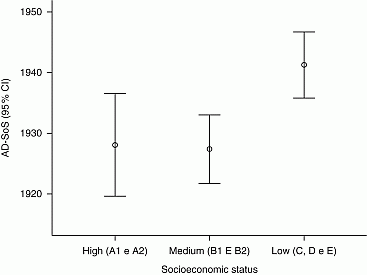ICCBH2013 Poster Presentations (1) (201 abstracts)
Comparison of socioeconomic status on bone mass assessed by quantitative ultrasound of the phalanges in girls from 7 to 15 years old
Juan Eduardo Samur-San Martin , Luiz Carlos de Barros Ramalho , Ezequiel Moreira Gonçalves , Fábio Bertapelli , Vinicius Barbeta , Tathyane Krahenbuhl , Roberto Regis Ribeiro , Roberto Teixeira Mendes & Gil Guerra-Junior
Center for Investigation in Pediatrics, University of Campinas, Campinas, São Paulo, Brazil.
Several environmental and genetic factors may interfere on bone mass in children. However, the pediatric studies that approach the socioeconomic status and quantitative ultrasound (QUS) parameters are scarce. The aim of this study was to compare the bone mass in girls from 7 to 15 years old of different socioeconomic status. The sample consisted of 860 Brazilian girls (8.95±1.32) of different socioeconomic status. The bone mass parameter, amplitude dependent speed sound (AD-SoS) in meters for seconds (m/s) was assessed for QUS of the proximal phalanges using DBM Sonic BP (IGEA, Carpi, Italy) device. The socioeconomic status was classified according to the Economic Classification Criteria Brazil of Brazilian Association of Research Company (ABEP-Brazil). Regarding to the socioeconomic status, most girls (43.6%) were classified in the lower class. The AD-SoS values were significantly higher (P<0.05) in the lower class (1941.2±53.7) when compared to medium (1927.4±52.1) and high class (1928.1±54.0), as illustrated in Fig. 1.

Figure 1 Comparison of AD-SoS values according to the socioeconomic status.
In conclusion, the results presented in this study demonstrates that socioeconomic factors may interfere significantly on the bone mass of the population studied.
 }
}



